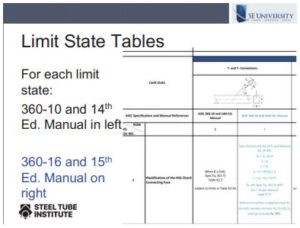HSS Connection Design: A New Approach
AISC 360-16 has some significant changes in the design of connections to rectangular HSS. Engineers have no doubt noticed the removal of some of the HSS connection design tables, however the limits of applicability included in the design tables became an impetus for AISC to provide a more flexible design process for HSS connections.
In the January 2021 SE University session, Kim Olson, PE, from Nucor and presenting on behalf of the Steel Tube Institute, presented Navigating AISC 360-16 HSS Connection Design. Kim identified how the prescriptive nature of Chapter K has been changed to more closely match the rest of the Specification. She also explained the reasoning behind the changes to the limits of applicability and variables in Chapter K and showed how the equations for connecting to the web of a wide flange member from Chapter J can be used to derive similar equations for connecting to rectangular HSS.
The most visible change in AISC 360-16 is the movement away from the prescriptive tables in AISC 360-10 for connecting to rectangular HSS. Although the tables were quick and useful, they were limited in scope and unique in style to the rest of the specification. The new design procedure is specified in Section K2.3 of AISC 360-16 which states that “The available strength of connections to rectangular HSS with concentrated loads shall be determined based on the applicable limit states from Chapter J.”
Referring to Chapter J for this procedure allows the engineer the ability to determine the strength of their exact connection without being limited to the prescribed limits previously included in the specification. More limit states must be checked to determine which controls which is in line with a typical steel connection design.
In order to more smoothly transfer from the prescriptive tables to the equations for HSS, Kim shared that the Steel Tube Institute has provided Limit State Tables on their website which highlight what was provided previously in AISC 360-10 and guidance for applying the equations in Chapter J of AISC 360-16 to HSS connections. As you can see below, the left column in black shows 360-10 / 14th Edition Manual and the new 360-16 / 15th Edition Manual is shown in blue text on the right.
The Limit State Tables serve as a transition key from 360-10 to 360-16 and will provide any limits of applicability for each connection as well as any end distance requirements. For each limit state, connection capacity equation references are shown with variable substitutions specific to HSS members, which is especially helpful when using yield line theory for plastification.
Overall, the usefulness of these new Limit State Tables should alleviate any heartache over the removal of the prescriptive tables for HSS connection design from the AISC manual. The new guidance on using the equations from Chapter J in AISC 360-16 will allow engineers to determine the capacity of connections whose geometry may not match those present in 360-10 and the design process more closely matches that of typical wide flange connections. Click to access these Limit State Tables which are available for FREE on the Steel Tube Institute’s website.



There are no comments yet, but you can be the first